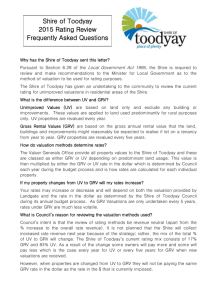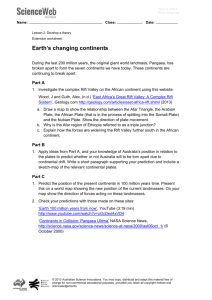res4_21_great_rift_valley_0
advertisement
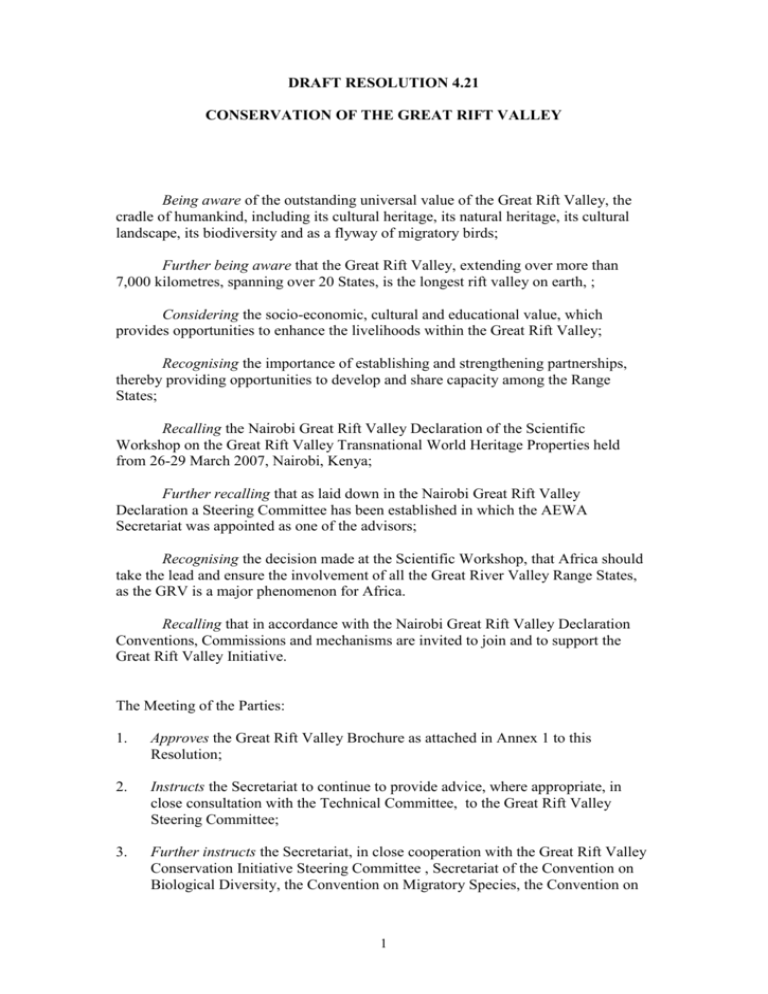
DRAFT RESOLUTION 4.21 CONSERVATION OF THE GREAT RIFT VALLEY Being aware of the outstanding universal value of the Great Rift Valley, the cradle of humankind, including its cultural heritage, its natural heritage, its cultural landscape, its biodiversity and as a flyway of migratory birds; Further being aware that the Great Rift Valley, extending over more than 7,000 kilometres, spanning over 20 States, is the longest rift valley on earth, ; Considering the socio-economic, cultural and educational value, which provides opportunities to enhance the livelihoods within the Great Rift Valley; Recognising the importance of establishing and strengthening partnerships, thereby providing opportunities to develop and share capacity among the Range States; Recalling the Nairobi Great Rift Valley Declaration of the Scientific Workshop on the Great Rift Valley Transnational World Heritage Properties held from 26-29 March 2007, Nairobi, Kenya; Further recalling that as laid down in the Nairobi Great Rift Valley Declaration a Steering Committee has been established in which the AEWA Secretariat was appointed as one of the advisors; Recognising the decision made at the Scientific Workshop, that Africa should take the lead and ensure the involvement of all the Great River Valley Range States, as the GRV is a major phenomenon for Africa. Recalling that in accordance with the Nairobi Great Rift Valley Declaration Conventions, Commissions and mechanisms are invited to join and to support the Great Rift Valley Initiative. The Meeting of the Parties: 1. Approves the Great Rift Valley Brochure as attached in Annex 1 to this Resolution; 2. Instructs the Secretariat to continue to provide advice, where appropriate, in close consultation with the Technical Committee, to the Great Rift Valley Steering Committee; 3. Further instructs the Secretariat, in close cooperation with the Great Rift Valley Conservation Initiative Steering Committee , Secretariat of the Convention on Biological Diversity, the Convention on Migratory Species, the Convention on 1 Wetlands (Ramsar), the World Heritage Centre and UNEP, to develop plans for further protection of the Great Rift Valley and to prepare concrete proposals to be submitted to the fifth Session of the Meeting of the Parties; 4. Invites all Range States along the Great Rift Valley to support and implement the Great Rift Valley Initiative; 5. Urges Contracting Parties, Range States and specialised international organisations to support the implementation of the Great Rift Valley Initiative; 6. Requests the Executive Secretary to continue mobilizing resources, including through the Global Environment Facility, to support the Range States in capacity building initiatives, to implement the Great Rift Valley Initiative and related issues. 7. Requests bilateral and multilateral donors to provide financial assistance for the Great Rift Valley Initiative; 8. Instructs the Secretariat to widely disseminate the Great Rift Valley Brochure and to seek appropriate donors to support the Great Rift Valley Initiative. 2 Annex 1 1.0 INTRODUCTION The Great Rift Valley (GRV) is one of the Earth’s most remarkable geological features. It is also the longest Rift Valley on earth and spans two continents. Stretching from Turkey through the Middle East, down to Botswana and Mozambique over a distance of 7.000 kilometres it covers areas in 21 countries being: Turkey, Syria, Lebanon, Israel incl. the Palestine Authority region, Saudi Arabia, Yemen, Egypt, Sudan. Djibouti, Eritrea, Ethiopia, Uganda, Rwanda, Kenya, the Democratic Republic of Congo, the United Republic of Tanzania, Malawi, Zambia, Botswana and Mozambique. The GRV is known for its outstanding universal value. Annually, billions of migratory birds use the GRV as a flyway. Also other migratory species, like wildebeest, migrate within the GRV and its many nature conservation areas serve as habitats to unique biodiversity. The richness of biodiversity is the reason that the GRV is one of the top destinations for tourists visiting Africa. According to the World Tourist Organisation (UNWTO) over 1.5 million tourists visited Kenya in 2005 and by doing so they spent US $ 579 million. Tourism in Africa is still increasing at a rate of 10 percent per year. The GRV is the cradle of humankind due to the fact that Lucy, the oldest hominid ever discovered with an estimated age of 3.2 million years, was found in Ethiopia. Harbouring cultural significance is also one of the features of the GRV. Rock art can be found at several places and is often the only link to previous civilisations which used to inhabit them. These rock paintings and engravings help us to understand how our ancestors thought, saw and portrayed their world. However, the existing cultural and natural wealth of the GRV is threatened due to the increase of the human population and the resulting need for more space for urbanisation, infrastructure and agriculture. Thus, there is a need to conserve the outstanding universal value of the GRV for future generations. 2.0 INSTRUMENTS TO CONSERVE THE GREAT RIFT VALLEY Each country located within the GRV has the sovereignty to conserve and protect its part of the Rift Valley. However, taking into account that the GRV spans 21 countries, an international instrument would undoubtedly provide better means to cover the whole area and to ensure an integrated approach. The Great Rift Valley as a World Heritage Site As indicated in the Introduction the GRV is of universal value with respect to archaeology, culture and biodiversity. The only international legal instrument that could cover all of these aspects is the World Heritage Convention. Exclusively biodiversity-related instruments such as the Ramsar Convention on Wetlands, the Convention on Migratory Species (CMS) and the African-Eurasian Migratory Waterbird Agreement (AEWA) would not have the mandate to cover all the conservation aspects of the GRV. Thus the idea is to go for serial nomination of the GRV as aWorld Heritage Site under the World Heritage Convention. However, at the same time the above-mentioned instruments could be used, where applicable, to ensure the conservation of migratory species and wetlands of international importance. 3.0 WORLD HERITAGE CONVENTION (WHC) In 1972 the Convention concerning the Protection of the World Cultural and Natural Heritage (WHC) was adopted by UNESCO. The mission of WHC is to encourage countries to sign the WHC, to nominate sites within their national territory for inclusion of the World Heritage List and to ensure protection of these natural and cultural sites. 830 sites in 138 countries are currently represented on the World Heritage list. 50 % of these sites are located in Europe, but just 8 % (29 sites) in Africa, which is, therefore, substantially underrepresented on the list. The GRV plays host to some of the world’s greatest geographical features from the Mosi-o-Tunya (Victoria Falls) in Zambia to the wildebeest migration on the Mara River (Kenya-Tanzania), reflecting its natural and cultural wealth. Many of the countries crossed by the GRV already have some sites listed on the WHC list, some of which are within the GRV. However, many more sites of universal value are not yet listed. Of the 29 African sites listed at the WHC list so far five are located in the Democratic Republic of Congo; eight in Ethiopia; three in Kenya; one in Malawi; one in Mozambique; one in Uganda; one in the United Republic of Tanzania and one trans-boundary site in Zambia and Zimbabwe. Listing further sites has proved to be a long and difficult process for most of these countries along the GRV. The GRV Conservation Initiative was launched as a joint effort to strengthen the conservation of sites with outstanding universal value to humanity within the GRV. The serial nomination of outstanding sites within the GRV will enable The Great Rift Valley as a World Heritage Site future generations to appreciate the beauty of the earth and the culture of its inhabitants. 4.0 WORLD HERITAGE SITES WITHIN THE GREAT RIFT VALLEY 4.1 The Great Rift Valley as a Serial World Heritage Site Several key sites within the GRV are cross-border areas and significant to countries that share this resource. The Chimanimani Mountains, shared between Zimbabwe and Mozambique, is a good example of such a trans-boundary site. The GRV is globally important as a flyway for migratory birds. The Palaearctic African Bird Migration sees over 5,000 million birds on the move every year. The birds may travel 8,000 kilometers or more annually, from their northern breeding grounds in Europe and Asia to Africa, along the GRV. Some 100 important bird areas have been identified by BirdLife International within the GRV. Many of these are water bodies and crucial to the migration of waterbirds. 4.2 (Insert photo of birds migrating or just birds) Sites Significant to Human Evolution The GRV is also famed for being the cradle of mankind. Paleontological and archeological sites in Ethiopia, Eritrea, Kenya and Tanzania, among others, tell the story of human evolution. Lucy, the oldest hominid ever discovered, with an estimated age of 3.2 million years, was found in the Ethiopian part of the GRV. Preserving these sites of universal value will safeguard humankind’s evidence of past existence and also the rights of our children to witness humankind’s rich history themselves. (Insert photo of Lucy the Hominid) 4.3 Sites with Cultural Significance Sites with rock art are scattered across the GRV. Today, this art helps us understand how our ancestors thought, saw and portrayed their world. Some rock paintings and engravings are magnificent works of art in their own right; comparable to some of the finest works found in the world's art galleries. (Insert photo with relevance to this theme) 4.4 Sites with Natural Significance The Great Rift Valley as a World Heritage Site Mosi-o-Tunya (Victoria Falls) is one of the longest waterfalls on Earth, 1.6 km wide with a maximum drop of 420 ft (128 m) on the Zambezi River on the Zambia-Zimbabwe border. This is a site that is at risk of being delisted due to the impending construction of a tourist resort just 7 km upriver from the falls. (Insert photos of relevance to the theme: Victoria Falls, Gorillas in Uganda, L.Malawi, L.Tanganyika, the Viruunga Massif) Lake Malawi, in Malawi, was inscribed on the WHS list in 1984 and is one of a number of natural sites, in need of the protection, which is afforded by the WHS listing, proposed by the Malawian Government. The Democratic Republic of Congo (DRC) has 64 protected sites and five existing World Heritage Sites. Natural sites suggested as additions include Lake Edward, a GRV Lake shared by DRC and Uganda; the Virunga Massif, an important mountain forest habitat for Gorillas also shared between Uganda and DRC; the Rusizi delta important for birds, hippos and crocodiles, shared between Rwanda, Uganda and the DRC; and Lake Tanganyika, shared between Rwanda, Tanzania, Burundi and the DRC. 5.0 REASONS FOR LISTING SITES ON THE WHC LIST The advantages of inscribing sites onto the WHS List are numerous, not only to the states, but also to future generations. For example: 6.0 The list serves as a catalyst to raise awareness for heritage preservation; Sites inscribed on the World Heritage list also benefit from the elaboration and implementation of a comprehensive management plan that sets out adequate preservation measures and monitoring mechanisms; Listing raises public awareness of the site and of its outstanding values, also acting as a spur for tourism. TRANS-BOUNDARY SERIAL NOMINATION The World Heritage Guidelines define serial nomination as “any nomination which consists of two or more unconnected areas”. A single World Heritage nomination may contain a series of cultural and/or natural properties in different geographical locations, provided that they are related because they belong to: The same historic-cultural group; The same type of property, which is characteristic of the geographical zone; or The same geological, geomorphologic formation, the same biogeographic province, or the same ecosystem type, and provided The Great Rift Valley as a World Heritage Site that it is the series, and not necessarily each of its components taken individually, which is of outstanding universal value. A potential case for serial nomination are the Silk Roads in Central Asia and China (April 2007, Dushanbe, Tajikistan). The Silk Roads formerly flourished due to the trade that was carried out along the route. In highlighting the serial site’s value, emphasis was placed on two things: the exchange and dialogue among countries and regions; and the multiplicity of dimensions that extends and enriches its primary function. In so doing the different areas along the route were threaded together like beads on a string, each with its own identity and value. The WHC has suggested the concept used for the Silk Roads as an example for the future serial nomination of the GRV. There are many similarities between the two. Both involve a wider geographical region with a common factor binding them; there are a number of individual member states involved; and there are specific efforts towards recognising and maintaining various sites for future generations. While each of the countries involved is a sovereign state, with their own specific interest, each also recognises the universal value of sites within the GRV. Hence their coming together, under the guidance of experts from various disciplines, to preserve, conserve, and maintain the treasure that is the GRV for future generations. 7.0 STEPS TAKEN TOWARDS SERIAL NOMINATION SO FAR The idea of a serial nomination of the GRV as a World Heritage Site has been discussed on numerous occasions. The most recent meetings took place in 2007 namely: 1) the scientific workshop on the GRV serial trans-national World Heritage Property, Kenya, 26-29 March 2007; 2) the meeting on the GRV Conservation Initiative, New-Zealand, 27 June 2007; and 3) the meeting on the GRV Conservation Initiative, France, 25-27 October 2007. The main focus of these meetings was the serial nomination of sites within the GRV. At the end of the scientific workshop held at the UN complex in Gigiri/ Nairobi, the Nairobi GRV Declaration was adopted. This declaration among other items: 1) Recommends the establishment of a Steering Committee comprising five State Parties and Advisory bodies being: BirdLife International, AEWA Secretariat, WWF and the World Heritage Centre; 2) Invites other Conventions, Commissions and mechanisms to join and support the GRV Conservation Initiative. The Great Rift Valley as a World Heritage Site The AEWA Secretariat participated in the scientific workshop mentioned-above and committed itself to bringing the GRV Conservation Initiative to the attention of the biodiversity-related Multilateral Environmental Agreements and to compile this brochure. Furthermore, the AEWA Secretariat, as part of the Advisory body, agreed to provide advice to the Steering Committee. Finally, during the scientific workshop in Nairobi, it was recognised that the GRV is a major phenomenon for Africa. Therefore, the meeting agreed that the GRV Conservation Initiative should be led by Africa. The National Museums of Kenya agreed to initially host and support the Steering Committee. UNEP was invited to provide support to the National Museums of Kenya to enable them to fully meet their obligations regarding the Steering Committee. Although it was decided to give the lead to Africa, this does not mean that the GRV countries outside Africa are excluded. On the contrary, the GRV Conservation Initiative focuses on the whole GRV, from Turkey to southern Africa and all 21 countries are encouraged to support this initiative and to collaborate together, with a view to conserve the GRV for future generations.


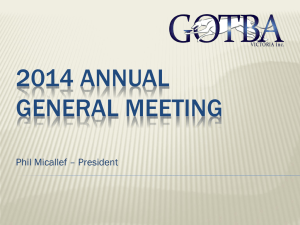
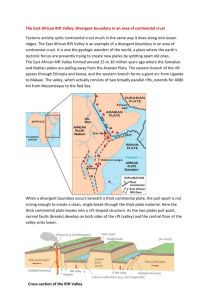
!["Human Origins in Africa" [BB09]](http://s2.studylib.net/store/data/005801692_1-b5b40078f7d5ae773e8789f2ec514d2f-300x300.png)
